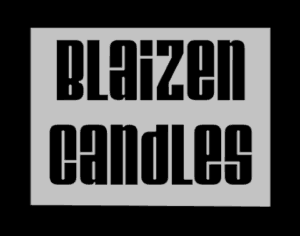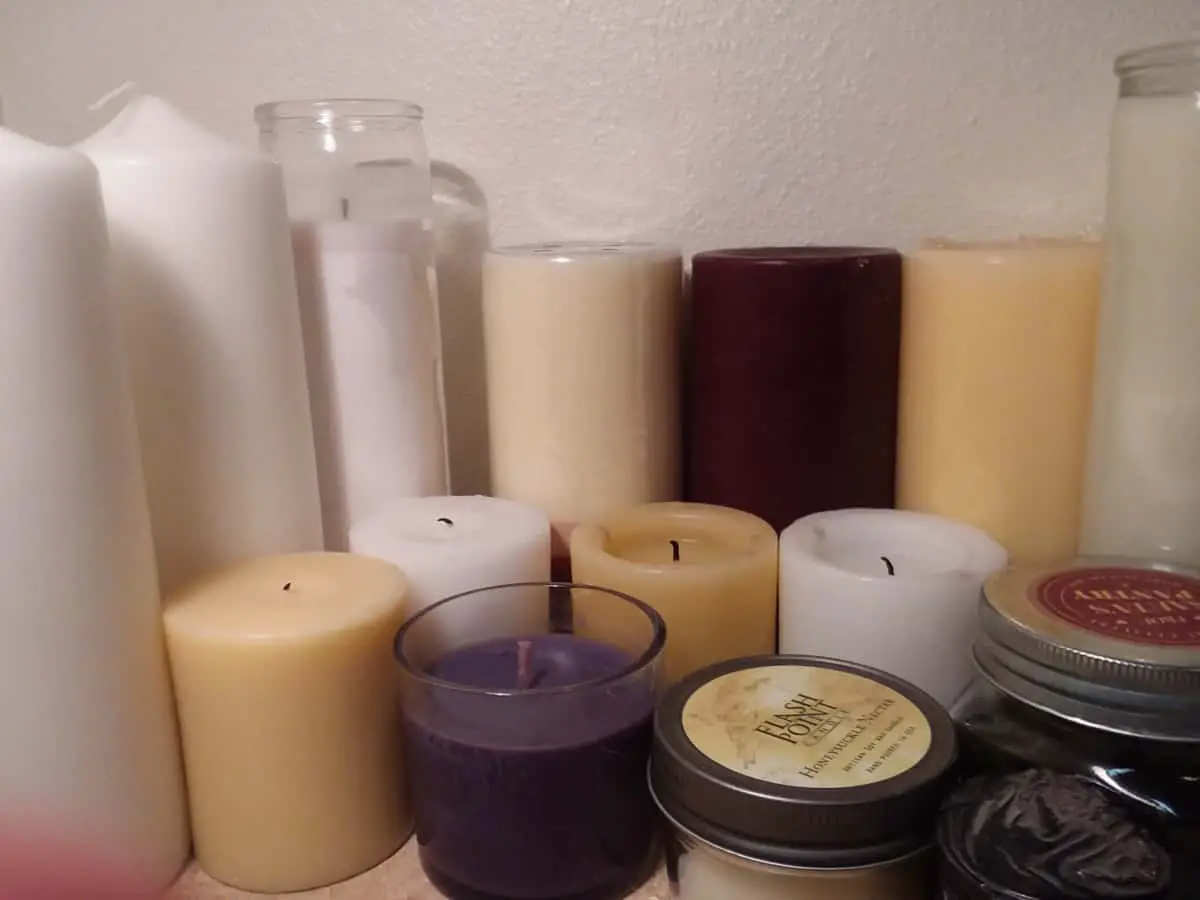If you are like me, you might have stock piles of candles stored away. Some of them may even be years old. So, with that, one question comes to mind.
Do candles spoil or “go bad”? Yes, candles can “spoil” or “go bad” by losing their scent, which is the cold throw, and losing their color, which will lead to a poor hot throw and dye discoloration. It is possible, although rarely seen, for soy wax, palm wax, and candles made with essential oils to “rot,” because they are made from “organic” materials.
Therefore, proper storage is so important. If you would like to learn more about how a candle can “rot,” “spoil,” or “go bad,” as well as proper candle storage techniques, please read on!
How Candles “Go Bad”
If a candle is left unsealed or exposed to direct sunlight, it will lose its scent and color.
Pillar and taper candles that are left out on display for extended periods of time are most likely to lose their scent over time. However, container candles with covers are more likely to retain their scent and be preserved if sealed and stored properly.
There are many components to proper candle storage (i.e., temperature, light, and air exposure), which I will discuss in the last section.
UV Radiation from the sun creates a chemical reaction and a breakdown in the wax, which causes it to discolor. UV rays weaken and destroy the raw materials and chemical bonds within the candle.
There are additives that can be placed in the wax, which will lessen this reaction, but is not completely avoidable. These UV absorbers protect candles from this chemical reaction. They work by collecting the UV radiation and releasing the energy as heat, which prevents the candle from discoloring. They absorb more of the UV light or energy than the candle does itself.
This loss of color can also be caused by indoor or artificial light, such as fluorescent lights.
No matter which or how many UV protectors or additives you add to the wax, a candle can never be fully protected from UV radiation. Adding dye/fragrance combinations alters the wax, as well, which can also cause discoloration or oxidation.
What is Oxidation? In simple terms, oxidation is generally described as a chemical reaction with oxygen. It is an exothermic reaction, meaning energy (in the form of heat) is produced. However, oxidation does not always have to involve oxygen. Scientifically defined, oxidation is actually the loss of electrons, which causes an increase in the oxidation state (or charge) of an atom.
Oxidation is a chemical reaction involving the moving of electrons.
Wax that contains a lot of dyes and fragrances is less thermally stable. It is more sensitive to fluctuations in temperature and heat than candles not dyed or fragranced. An additive called an anti-oxidant can be included in the manufacture of the candle wax, which will help to lessen this effect and make the candle more thermally stable.
Do Candles Have an Expiration Date? What is the Best Wax to Use?
Do candles expire? Yes, candles do expire. Candles “go stale.”
Generally, it is recommended that you use your candle within a year, once you open it from its original packaging, especially if it is a natural wax, such as soy or palm wax.
The expiration date for a candle is about one year, once it has been opened from its original packaging, unless it has been properly stored.
Soy and palm waxes are considered “organic” or “natural” waxes, because they are made from soybeans and palm berries (fruit), respectively.
They are considered renewable resources and environmentally-friendly.
These types of waxes can “rot,” just like food, because they are “organic” materials.
Vegetable waxes have a shorter life span than paraffin waxes. Soy wax is essentially super-hydrogenated soybean oil (like Crisco, an all-vegetable shortening). So, yes, it can go bad, just like Crisco can. Crisco doesn’t or cannot last forever. Soy wax has a “shelf life” of 2 years max, even when stored properly.
Soy wax has a “shelf life” or expiration date of 2 years.
Crisco is made from a blend of soybean oil, fully hydrogenated palm oil, and partially hydrogenated palm and soybean oils.
However, palm wax is a hard wax and has a higher melting point than soy (or paraffin). This higher melting point means palm wax candles burn more slowly and are more thermally stable. The chemical structure of palm wax also allows it to be able to hold onto fragrance better than other waxes.
Palm wax has a large, crystal-like molecular structure, which permits it to attach to more of the fragrance that is added. Therefore, palm wax is able to hold onto more fragrance and release it more slowly than soy wax.
Candles made with essential oils may “rot,” as well, because they are considered organic and made from plants and flowers, just like palm wax. Most essential oils have their own expiration date, set by the manufacturer.
Essential oils have a shelf life, because they can start to break down. The chemical, or molecular, structure of the essential oil starts to change over time (as a result of oxidation), thereby, impacting the scent/aroma of the oil.
Oxygen, heat, and light are the 3 components that contribute to the oxidation process and affect the shelf life or expiration date of an essential oil. The shelf life, or expiration date, of an essential oil varies greatly on the components within the oil. It can vary from one year, all the way up to 8 years.
The shelf life, or expiration date, of essential oils vary greatly, from 1-8 years, based on the components within the oil.
Paraffin wax is considered to have a very long “shelf life” of at least 5 years, but a max number is hard to determine. It is made from petroleum.
The shelf life, or expiration date, of paraffin wax is at least 5 years.
Beeswax is the most well-preserved wax to use. It can be stored for a significant period of time with little to no degradation, but it needs to be wrapped and stored properly.
Beeswax is, of course, made by bees. Beeswax is considered to have no expiration date. The ancient Egyptians used beeswax for the mummification process.
Beeswax is considered to have NO expiration date.
When solely considering the “shelf life” or expiration date of a wax, the best wax to use is beeswax. However, there are other factors to consider when making a candle. The candle-making process is complex and consists of various nuances.
Determining Factors for How Long a Candle Will Last
- Type of Wax: Burn Rate and Shelf Life. The first determining factor for how long a candle will last is the type of wax, because each wax has a different burn rate and shelf life. Soy and beeswax are considered to be the longest burning waxes, but soy wax has a shorter shelf life than beeswax.
- Additives. Any additives included in the wax can impact the burn time of the candle. As discussed earlier, it is common to add UV inhibitors and other additives to the wax to increase cold throw, optimize hot throw, and preserve color. Also, anti-oxidants can be added to make the candle more thermally stable. However, all of these additives will affect how the candle burns. Therefore, these additives may prolong the “shelf life” or “display time” of the candle, but will ultimately affect the burn time or effectiveness of the candle burn, including increase sooting.
- Fragrance/Essential Oils. The fragrance and/or essential oils that are added for the scent, or aroma, of the candle can affect the burn rate of the candle. The scent, or aroma, is the main component of the candle that people consider. People are looking for candles that smell nice, that is, in fact, why they buy them. However, the fragrance load can have an impact on the burn rate of the candle, how the candle will burn, and how long the candle will last. If you put too much fragrance into the wax, it could cause the candle to not burn properly by clogging the wick.
- The wick. Choosing a proper wick for the candle you are making is so important. The wick needs to be the proper size, burn at a steady pace, and not clog.
Proper Storage of Candles and Wax
As already stated earlier, proper storage of the wax and the candles is super important for the life of the candle. To preserve the wax or candle, it needs to be stored appropriately. Here are the optimal storage suggestions to extend the life of your wax and candles.
- Keep sealed or wrapped. Keeping the wax and candles sealed or wrapped helps to prevent oxidation and preserve the chemical structure of the compound, including the scent and color. Wax should be stored in a sealed, water-proof plastic bag. Capping essential oil bottles to lessen contact with oxygen will help prevent oxidation. Pillar, taper, and votive candles should be wrapped. Container candles should have a lid that is securely tightened.
- Keep out of direct sunlight. Keeping candles out of direct sunlight and away from artificial lighting will lessen color degradation. As mentioned earlier, candles are sensitive to UV radiation and will change color if left near sunlight exposure or under direct artificial light for extended periods of time.
- Keep cool. Wax and candles are sensitive to temperature variations. It is best to know the melting temperature of the wax you have. Always keep wax and candles at room temperature or below.
- Keep dry. Humidity can affect the candle and wax. Keep the wax and candle dry and out of high humidity places.
- It is best to store in a cool, dry, dark place. Keeping the wax or candles stored in a cool, dry, dark space, will prolong the shelf life.



